Spring Onions
BackSpring onions are fast and easy to grow, so they’re great for beginners and perfect for squeezing into small spaces. It’s their sweet and mild flavor that makes them ideal for fast cooking or garnishing dishes. Add them to scrambled eggs for a subtle onion flavour, chop them into matchstick lengths for quick stir fries or finely diced they can be used as a garnish on nearly everything.
How to Grow Spring Onions
Spring onions can be grown year round in a full sun to part shade position. Although they will grow more vigorously during the warmer months, they can still be grown throughout winter as they’re frost tolerant.
Grow spring onions in a soil that is well drained and rich in organic matter. If growing from seed they can either be sown directly into the veggie bed or into punnets first. Cover lightly and water with OCP eco-seaweed to encourage germination. Seeds will take 10-14 days to germinate and during this time it’s important the soil is kept moist but not wet. Seed will rot if kept wet. Seedlings are also readily available from garden centres and nurseries.
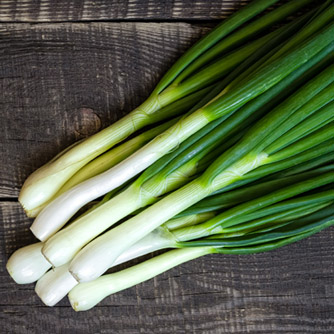
Spring onions cleaned and ready for cooking
When planting out seedlings it’s easiest to make a shallow furrow and lay the seedlings into it spaced 2-4cm apart. You can then quickly backfill by running your hand down one side pushing soil over the roots. Don’t worry if the seedings aren’t standing upright as they will correct themselves as they establish.
Although row planting makes for a neat and tidy veggie patch they don’t have to be planted this way. As each plant doesn't take up much space you can easily fit them into random empty spots anywhere in your veggie garden.
As your plants grow remove any weeds that appear and once the seedlings are large enough spread sugar cane mulch around to suppress weeds and improve moisture retention. There’s generally no need to thin out spring onion seedlings as you can begin harvesting the smaller ones as quickly 8-10 weeks after planting.
Spring onions will also grow well in pots or containers. Choose a pot that is at least 15cm deep and allows for good drainage. Watch them during hot weather as potted plants will dry out faster and need more frequent watering than those growing in beds.
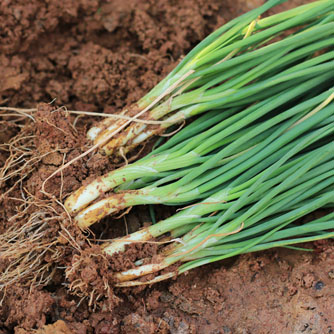
Freshly harvested spring onions
Sowing Guide for Spring Onions
| Growing Zone | Sowing Time |
| Cool Zones | Spring, Summer, Autumn, Winter* |
| Mediterranean Zones | Spring, Summer, Autumn, Winter* |
| Warm & Temperate Frost Free Zones | Spring, Summer, Autumn, Winter |
| Tropical & Subtropical Zones | Spring, Summer, Autumn, Winter |
* Seeds sown during winter in Cool and Mediterranean zones will be very slow to grow. Try starting them off indoors or in a greenhouse to compensate.
Fertilising & Maintenance of Spring Onions
Spring onions require minimal care and maintenance, but a regular dose of OCP eco-seaweed and OCP eco-aminogro will get them growing faster. Reduce weed competition by mulching around your plants and make sure they are well watered during extremely hot weather to prevent wilting and drying out.
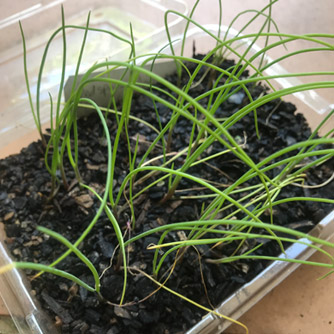
Spring onion seedlings ready to be planted out
Harvesting Spring Onions
Spring onions can be harvested 8-10 weeks after sowing seeds or once the plants are roughly the thickness of a pencil. In the cooler months they will grow more slowly and may reach harvesting size in 12-14 weeks.
When ready to harvest you can either pull the plant completely out of the ground, harvesting it all OR cut the shoot off about 1cm above ground level. The remaining stump will then reshoot giving you'll a continual crop.
If you do pull out the entire plant then be sure to re-sow or re-plant seedlings every 3-4 weeks so you have a continuous supply.
Pests and Diseases of Spring Onions
Spring onions are relatively pest and disease free. However the following problems may occur under specific conditions:
- Snails and slugs - Young spring onion seedlings can be susceptible to attack by snails and slugs. Scatter OCP eco-shield pellets around for protection when they’re young and vulnerable.
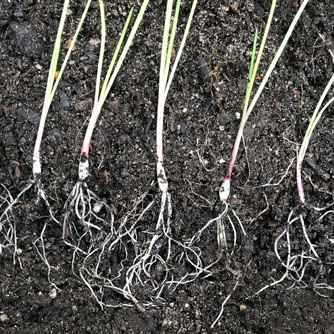
Planting out spring onion seedlings
- Sap sucking pests - things like aphids and thrips can sometimes can attack spring onions. One option is regular foliage sprays of OCP eco-seaweed and OCP eco-aminogro to encourage healthy growth that is better able to resist pests. Another is to include plants like alyssum and marigolds amongst your vegetables to attract beneficial insects like ladybeetles and lacewings that will feast on these pests. And lastly you can spray an organic insecticide registered for the particular pest you have.
- Poor germination – Most commonly due to being kept too wet with the seeds rotting away before they can germinate. Cut back on your watering but remember the soil, or potting mix, must not dry out completely otherwise seeds will also fail.
- Foliage diseases – spring onions which don’t get enough sunlight or air flow are more susceptible to foliage diseases like downy mildew and bacterial spot. If you experience these issues then move plants to a better position which allows the morning dew to dry quickly on plants. Regular foliage sprays of OCP eco-seaweed and OCP eco-aminogro can boost plant health to help reduce disease incidence.
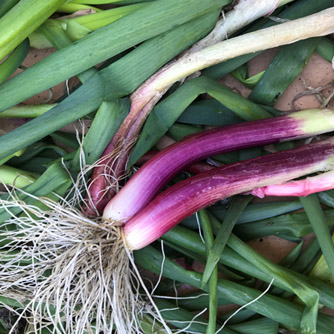
Red stemmed spring onions are also available


